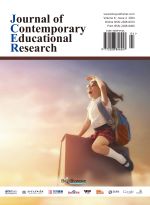Abstract
This study focuses on the master of arts education in higher education institutions in Guangxi Zhuang Autonomous Region of China, explores the path of integrating Guangxi Zhuang’s intangible cultural heritage with the teaching of master of arts, and puts forward the teaching mode of “thinking guidance-autonomous judgement-program construction.” A theoretical model of innovative transformation of intangible cultural heritage is also summarized. Through the development of this study, it is expected to further enrich the practical teaching mechanism of master of arts education in Chinese universities and form a master of arts teaching model with strong local cultural characteristics. At the same time, the teaching reform based on the integration of Guangxi Zhuang’s intangible cultural heritage and master of arts education also has strong practical significance for promoting the inheritance and innovation of Chinese intangible cultural heritage, promoting the development of cultural and creative industries, and serving the economic and social development of Guangxi.
References
He J, Liu D, 2024, Learning from the Past and Knowing the New--Review and Thoughts on Professional Degree Graduate Education in the Field of Art and Design. Art Education, 2024(02): 30.
Yang E, 2023, Research on the Teaching Reform of Film and Television Courses in Colleges and Universities on the Integration of “Non-Legacy.” Journal of Zunyi Normal College, 2023(01): 127–129.
Chen C, 2018, Exploration of Teaching Reform of Tourism Management Under the Perspective of Intangible Cultural Heritage Protection. Journal of Heihe College, 2018(07): 121–122.
Zong W, 2018, Research on Teaching Reform of Art Design Under the Perspective of Intangible Cultural Heritage Inheritance. Art Education Research, 2018(19): 132–133.
Wu N, 2014, Research on the Cultivation Mode of Master of Arts in the Field of “Intangible Cultural Heritage”--Taking the Cultivation of Master of Arts in Nanyin of Quanzhou Normal College as an Example. Education Review, 2014(02): 109–111.
Jiang H, Zhou W, 2020, Research on Talent Training Mode of Cultural Heritage Innovation and Transformation for Master of Arts in Cultural Ecology Perspective. China National Fine Arts, 2020(02): 80–83.
State Council, 2005, Notice of the State Council on Strengthening Protection of Cultural Heritage, viewed November 25, 2023, http://www.gov.cn/gongbao/content/2006
He Q, 2014, Legal Protection of Intangible Cultural Heritage of Ethnic Minorities in National Autonomous Areas-Taking the Protection of Intangible Heritage in Guangxi Zhuang Nationality Autonomous Region as an Example. Cultural Heritage, 2014(01): 41.
Guo Q, 2020, The Principle of “Professionalism,” “Practicability” and “Creativity” Should be Adhered to in the Postgraduate Education of Master of Arts--Taking the Field of Music and Dance as an Example. Degree and Postgraduate Education, 2020(09): 54.
Pan C, 2020, Reflections on the Graduate Education of Art and Design Degree in Comprehensive Universities. Art Education, 2020(07): 14.
